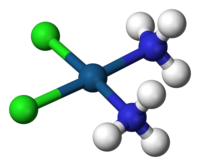
Photo from wikipedia
Abstract The synthesis, characterization and density functional theory calculations of mononuclear Ni and Cu complexes supported by the N,N′-dimethyl-N,N′-bis-(pyridine-2-ylmethyl)-1,2-diaminoethane ligand and its derivatives are reported. The complexes were characterized by… Click to show full abstract
Abstract The synthesis, characterization and density functional theory calculations of mononuclear Ni and Cu complexes supported by the N,N′-dimethyl-N,N′-bis-(pyridine-2-ylmethyl)-1,2-diaminoethane ligand and its derivatives are reported. The complexes were characterized by X-ray crystallography as well as by UV−visible absorption spectroscopy and EPR spectroscopy. The solid state structure of these coordination complexes revealed that the geometry of the complex depended on the identity of the metal center. Solution phase characterization data are in accord with the solid phase structure, indicating minimal structural changes in solution. Optical spectroscopy revealed that all of the complexes exhibit color owing to d-d transition bands in the visible region. Magnetic parameters obtained from EPR spectroscopy together with other structural data suggest that the Ni(II) complexes are in a pseudo-octahedral geometry and Cu(II) complexes are in a distorted square pyramidal geometry. In order to understand in detail how ligand sterics and electronics affect complex topology detailed computational studies were performed. The series of complexes reported in this article will add significant value in the field of coordination chemistry as Ni(II) and Cu(II) complexes supported by tetradentate pyridyl based ligands are rather scarce.
Journal Title: Inorganica Chimica Acta
Year Published: 2017
Link to full text (if available)
Share on Social Media: Sign Up to like & get
recommendations!